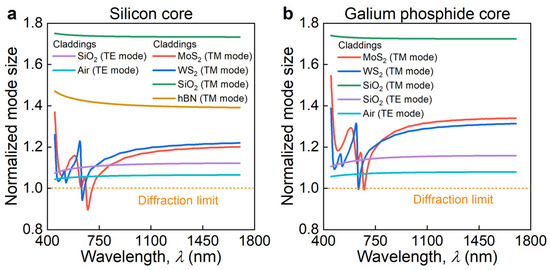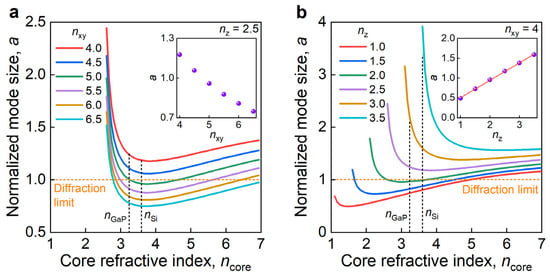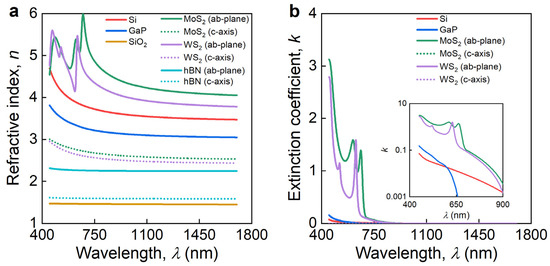Abstract
Photonics is a natural next technological step after an era of electronics. However, the diffraction limit of light poses severe limitations on photonic elements and dictates their size. Herein, we demonstrate that layered semiconductors solve this challenge thanks to their giant optical anisotropy. In particular, waveguides with molybdenum disulfide (MoS2) and tungsten disulfide (WS2) claddings can operate in a transparency region slightly above (20%) the diffraction limit and even overcome it by 10% around 700 nm, providing an even better confinement than air cladding, but with excitonic losses. Further analysis reveals that van der Waals materials with an in-plane refractive index of about five or an out-of-plane index around two provide subdiffractional and lossless guidance. Therefore, our results establish the route for ultra-dense photonic integration based on layered materials.
1. Introduction
A long-term objective of photonics engineers is the integration of optical components at the nanoscale [1,2,3,4,5,6]. To date, they have created a number of solutions, including plasmonics structures [7,8,9,10], photonic crystals [11,12,13], and anisotropic metamaterials [1,2,3,4,5]. However, photonic crystals are bulky [2,5], and metals, used in plasmonics, cause significant ohmic losses [14]. On the other hand, anisotropic metamaterials are reasonably compact and, simultaneously, do not produce extra losses. Instead of traditional isotropic cladding (Figure 1a), the concept entails employing an anisotropic dielectric tensor for cladding (Figure 1b) [1]. In that case, the evanescent wave’s momentum for transverse magnetic (TM) polarization is as follows [1]:
where and are dielectric permittivities of the metamaterial along the z and y directions (Figure 1), is the light wavevector in a vacuum, and is the wavenumber of the guided wave (Figure 1). Consequently, a high anisotropy ratio leads to the reduced evanescent tails since the penetration depth into the cladding is inversely proportional to [1,2,3,4,5,6], which is key for the anisotropic confinement of the waveguide mode. To achieve high , one may utilize silicon stripes [2,3,4], which become anisotropic in accordance with the Rytov relations [15,16] for the effective medium approximation of the refractive index n of metamaterials along different directions. When silicon is combined with air [3,4], this method can produce a birefringence () up to , whereas silicon is usually combined with silicon dioxide [2], which yields a birefringence of . For enhancing light confinement, this is sufficient, but it is not enough for subdiffraction light guidance.

Figure 1.
Variation of waveguide claddings. Planar waveguide with (a) isotropic, (b) anisotropic metamaterials, and (c) vdW cladding.
The above results have inspired an intensive search for artificial and natural giant optical anisotropies [6,17,18,19,20]. In this regard, recent reports [6,19,21] suggest the usage of van der Waals (vdW) materials (Figure 1c) because of their high in-plane and low out-of-plane refractive indices. This extraordinary optical response originates from strong in-plane covalent bonding and weak out-of-plane vdW forces, resulting in a giant anisotropy with in the infrared range and for visible wavelengths, which have been observed for molybdenum disulfide (MoS2) and tungsten disulfide (WS2) [6,19]. Additionally, the diversity of vdW materials, with more than 5000 compounds [22], suggests that these may not be the record values. Hence, vdW materials are a perfect platform for light confinement inside waveguides. In this work, we comprehensively discuss the prospects of optical anisotropy for reducing the waveguide mode’s size and, thus, improving the integration density of the optical elements on a chip.
2. Results
Similar to anisotropic metamaterials with alternating layers (Figure 1b), vdW materials have a uniaxial optical anisotropy with an optical axis perpendicular to the vdW layers. As a result, their dielectric tensor is diagonal (,,) and characterized by in-plane and out-of-plane refractive indices. Metamaterials can be prepared to have an optical axis along z [2] or x [2,3,4] directions, which allows for the leveraging of the anisotropic response for transverse magnetic (TM) and transverse electric (TE) polarizations, respectively. Despite the tremendous progress in the fabrication and preparation of vdW materials [23,24,25], this option remains closed to them because of their intrinsic positive anisotropy in a standard configuration [6]. Therefore, we focus on TM polarization, where the anisotropy of layered materials plays a paramount role.
In the first step, we analyzed MoS2 and WS2 as cladding materials (Figure 1c) since they are currently record holders regarding the highest optical anisotropy [6,19]. For the mode size calculations, we started with computations of the planar waveguide (Figure 1c) mode index , which is presented as follows [26]:
where is the waveguide’s core thickness, is the refractive index of the waveguide’s core, and is the free space wavelength of light. It is worth noting that in case of nonzero material optical losses (extinction coefficient ), is determined by the same equation, but instead of refractive index one should use a complex refractive index (). After the determination of , we computed the normalized mode size , defined as a sum of the core thickness and skin depths of the claddings [27], and divided by the diffraction limit size :
Performing these calculations for a series of core thicknesses, we find a minimum of for the given , , , and . Obviously, this minimum corresponds to an optimum value of a normalized mode size. We performed the above procedure for MoS2 and WS2 as claddings and silicon (Si) as a core, with the results presented in Figure 2. It is worth noting that instead of thick layers of MoS2 and WS2, one can leverage their monolayer form because of their similar anisotropic responses, but a monolayer thickness is not enough for a sufficient reduction in mode size. As expected, anisotropic materials’ claddings yield more than 40% higher light confinement than standard silicon dioxide (SiO2) for TM polarization (Figure 2). Notably, in the transparency region of MoS2 and WS2, the normalized mode size is almost at the diffraction limit, but it is not reached. Of immediate interest is the region around 700 nm, where a subdiffraction regime is achieved owing to the enormous birefringence of . This result is even better than that for a highly confined TE mode for an SiO2/Si/SiO2 structure (Figure 2a). However, at these wavelengths, silicon has high optical losses, and so do MoS2 and WS2 because their maximum anisotropies are located at exciton resonances. The replacement of silicon with gallium phosphide (GaP) greatly diminishes optical losses since GaP is transparent down to 600 nm [28], but the mode size increases, as seen from Figure 2b. Moreover, the losses in MoS2 and WS2 still remain and prohibit the long propagation of the waveguide mode.

Figure 2.
Subdiffraction guiding in waveguides with MoS2 and WS2 claddings. (a) Silicon core and (b) gallium phosphide core. The results for SiO2/Si/SiO2 and SiO2/GaP/SiO2 planar waveguides for both polarizations (TM and TE) are included for comparison. Optical constants, used for calculation, are presented in Appendix section (Figure A1).
To achieve lossless subdiffraction guidance, the next logical step is to find optimum values for the in-plane , out-of-plane , and core refractive indices. To solve this problem, we investigated the mode size as a function of these parameters. The main attention was devoted to the case where and because they are typical values for MoS2 and WS2 [6,19]. Figure 3a shows the decrease in the mode size with the increase in the in-plane component of the refractive index. From the graph, we conclude that a small increase in the in-plane refractive index by 1.0 is enough, and the required core refractive index range includes Si and GaP properties (Figure 3a). The situation is even more pronounced for the variation of (Figure 3b), where even a 0.5 change in corresponds to subdiffraction guidance. Surprisingly, the minimum of the normalized mode size behaves linearly with respect to the out-of-plane refractive index, as seen from the inset of Figure 3b. It is also worth mentioning that, again, the refractive index of GaP and Si belongs to the optimum interval of the core refractive index. As a consequence, the vdW material, with a slightly stronger in-plane or a slightly weaker out-of-plane optical response, is in high demand for an efficient degree of light confinement, while Si and GaP ideally complement the vdW materials’ optical anisotropy for lossless subdiffraction guidance.

Figure 3.
Parameter dependence of waveguide mode size. Optimal mode size for various (a) in-plane refractive indices at a fixed out-of-plane component () and (b) out-of-plane refractive index at a fixed in-plane component (). The insets show the minimum of normalized mode size dependence on in-plane and out-of-plane refractive indices.
3. Discussion
Anisotropic metamaterials offer a unique way to confine light in waveguides through the control of evanescent waves in waveguide claddings. Unlike plasmonics, this method does not introduce additional losses and, hence, is very promising for next-generation integrated circuits. However, a metamaterials approach requires giant optical anisotropy, which is difficult to create. Fortunately, van der Waals (vdW) materials inherently possess a highly anisotropic structure due to their layered nature, for instance, MoS2 and WS2, leading to giant optical anisotropy. Indeed, our results show that MoS2 and WS2 enable a degree of light confinement up to the diffraction limit without optical losses. Moreover, we determined optimum values of the in-plane and out-of-plane refractive indices of layered materials equal to 5.0 and 2.0, respectively, for subdiffraction guidance. Although the currently used layered materials do not satisfy these criteria in their transparency regions, they have very close characteristics: 4.0 for in-plane and 2.5 for out-of-plane refractive indices. Nevertheless, their rich diversity [22], heterostructures [29], and modifications [30,31] provide the possibility to tailor optical responses and reach the desired parameters, which were both found in our work.
Author Contributions
A.A., V.V., A.V. and G.E. suggested and directed the project. G.E., D.G., K.V. and A.V. provided theoretical support. G.E. wrote the original manuscript. All authors have read and agreed to the published version of the manuscript.
Funding
G.A.E. and D.V.G. acknowledge the support by the Russian Science Foundation (grant № 22-29-01192) https://rscf.ru/project/22-29-01192/.
Institutional Review Board Statement
Not applicable.
Informed Consent Statement
Not applicable.
Data Availability Statement
The datasets generated in and/or analyzed during the current study are available from the corresponding author on reasonable request.
Conflicts of Interest
The authors declare no conflict of interest.
Appendix A

Figure A1.
Optical constants of Si, GaP, SiO2, MoS2, WS2, and hBN, used in the work. (a) Refractive index and (b) extinction coefficient. The inset shows extinction coefficient in logarithmic scale.
References
- Jahani, S.; Jacob, Z. Transparent Subdiffraction Optics: Nanoscale Light Confinement without Metal. Optica 2014, 1, 96. [Google Scholar] [CrossRef]
- Jahani, S.; Kim, S.; Atkinson, J.; Wirth, J.C.; Kalhor, F.; Noman, A.A.; Newman, W.D.; Shekhar, P.; Han, K.; Van, V.; et al. Controlling Evanescent Waves Using Silicon Photonic All-Dielectric Metamaterials for Dense Integration. Nat. Commun. 2018, 9, 1893. [Google Scholar] [CrossRef]
- Mia, M.B.; Ahmed, S.Z.; Ahmed, I.; Lee, Y.J.; Qi, M.; Kim, S. Exceptional Coupling in Photonic Anisotropic Metamaterials for Extremely Low Waveguide Crosstalk. Optica 2020, 7, 881. [Google Scholar] [CrossRef]
- van Niekerk, M.; Jahani, S.; Bickford, J.; Cho, P.; Anderson, S.; Leake, G.; Coleman, D.; Fanto, M.L.; Tison, C.C.; Howland, G.A.; et al. Two-Dimensional Extreme Skin Depth Engineering for CMOS Photonics. J. Opt. Soc. Am. B 2021, 38, 1307. [Google Scholar] [CrossRef]
- Jahani, S.; Jacob, Z. All-Dielectric Metamaterials. Nat. Nanotechnol. 2016, 11, 23–36. [Google Scholar] [CrossRef] [PubMed]
- Ermolaev, G.A.; Grudinin, D.V.; Stebunov, Y.V.; Voronin, K.V.; Kravets, V.G.; Duan, J.; Mazitov, A.B.; Tselikov, G.I.; Bylinkin, A.; Yakubovsky, D.I.; et al. Giant Optical Anisotropy in Transition Metal Dichalcogenides for Next-Generation Photonics. Nat. Commun. 2021, 12, 854. [Google Scholar] [CrossRef]
- Bozhevolnyi, S.I.; Volkov, V.S.; Devaux, E.; Laluet, J.-Y.; Ebbesen, T.W. Channel Plasmon Subwavelength Waveguide Components Including Interferometers and Ring Resonators. Nature 2006, 440, 508–511. [Google Scholar] [CrossRef] [PubMed]
- Fedyanin, D.Y.; Yakubovsky, D.I.; Kirtaev, R.V.; Volkov, V.S. Ultralow-Loss CMOS Copper Plasmonic Waveguides. Nano Lett. 2016, 16, 362–366. [Google Scholar] [CrossRef]
- Thomaschewski, M.; Zenin, V.A.; Fiedler, S.; Wolff, C.; Bozhevolnyi, S.I. Plasmonic Lithium Niobate Mach–Zehnder Modulators. Nano Lett. 2022, 22, 6471–6475. [Google Scholar] [CrossRef]
- Minin, I.V.; Minin, O.V.; Glinskiy, I.A.; Khabibullin, R.A.; Malureanu, R.; Lavrinenko, A.; Yakubovsky, D.I.; Volkov, V.S.; Ponomarev, D.S. Experimental Verification of a Plasmonic Hook in a Dielectric Janus Particle. Appl. Phys. Lett. 2021, 118, 131107. [Google Scholar] [CrossRef]
- Hsu, C.W.; Zhen, B.; Lee, J.; Chua, S.-L.; Johnson, S.G.; Joannopoulos, J.D.; Soljačić, M. Observation of Trapped Light within the Radiation Continuum. Nature 2013, 499, 188–191. [Google Scholar] [CrossRef] [PubMed]
- Mekis, A.; Chen, J.C.; Kurland, I.; Fan, S.; Villeneuve, P.R.; Joannopoulos, J.D. High Transmission through Sharp Bends in Photonic Crystal Waveguides. Phys. Rev. Lett. 1996, 77, 3787–3790. [Google Scholar] [CrossRef] [PubMed]
- Dai, D.; Shi, Y.; He, S. Comparative Study of the Integration Density for Passive Linear Planar Light-Wave Circuits Based on Three Different Kinds of Nanophotonic Waveguide. Appl. Opt. 2007, 46, 1126. [Google Scholar] [CrossRef] [PubMed]
- Lebsir, Y.; Boroviks, S.; Thomaschewski, M.; Bozhevolnyi, S.I.; Zenin, V.A. Ultimate Limit for Optical Losses in Gold, Revealed by Quantitative Near-Field Microscopy. Nano Lett. 2022, 22, 5759–5764. [Google Scholar] [CrossRef] [PubMed]
- Hemmati, H.; Magnusson, R. Applicability of Rytov’s Full Effective-Medium Formalism to the Physical Description and Design of Resonant Metasurfaces. ACS Photonics 2020, 7, 3177–3187. [Google Scholar] [CrossRef]
- Rytov, S.M. Electromagnetic Properties of a Finely Stratified Medium. Sov. Phys. JETP 1956, 2, 446–475. [Google Scholar]
- Kats, M.A.; Genevet, P.; Aoust, G.; Yu, N.; Blanchard, R.; Aieta, F.; Gaburro, Z.; Capasso, F. Giant Birefringence in Optical Antenna Arrays with Widely Tailorable Optical Anisotropy. Proc. Natl. Acad. Sci. USA 2012, 109, 12364–12368. [Google Scholar] [CrossRef]
- Niu, S.; Joe, G.; Zhao, H.; Zhou, Y.; Orvis, T.; Huyan, H.; Salman, J.; Mahalingam, K.; Urwin, B.; Wu, J.; et al. Giant Optical Anisotropy in a Quasi-One-Dimensional Crystal. Nat. Photonics 2018, 12, 392–396. [Google Scholar] [CrossRef]
- Verre, R.; Baranov, D.G.; Munkhbat, B.; Cuadra, J.; Käll, M.; Shegai, T. Transition Metal Dichalcogenide Nanodisks as High-Index Dielectric Mie Nanoresonators. Nat. Nanotechnol. 2019, 14, 679–684. [Google Scholar] [CrossRef]
- Ermolaev, G.; Voronin, K.; Baranov, D.G.; Kravets, V.; Tselikov, G.; Stebunov, Y.; Yakubovsky, D.; Novikov, S.; Vyshnevyy, A.; Mazitov, A.; et al. Topological Phase Singularities in Atomically Thin High-Refractive-Index Materials. Nat. Commun. 2022, 13, 2049. [Google Scholar] [CrossRef]
- Ermolaev, G.A.; Stebunov, Y.V.; Vyshnevyy, A.A.; Tatarkin, D.E.; Yakubovsky, D.I.; Novikov, S.M.; Baranov, D.G.; Shegai, T.; Nikitin, A.Y.; Arsenin, A.V.; et al. Broadband Optical Properties of Monolayer and Bulk MoS2. npj 2D Mater. Appl. 2020, 4, 21. [Google Scholar] [CrossRef]
- Mounet, N.; Gibertini, M.; Schwaller, P.; Campi, D.; Merkys, A.; Marrazzo, A.; Sohier, T.; Castelli, I.E.; Cepellotti, A.; Pizzi, G.; et al. Two-Dimensional Materials from High-Throughput Computational Exfoliation of Experimentally Known Compounds. Nat. Nanotechnol. 2018, 13, 246–252. [Google Scholar] [CrossRef] [PubMed]
- Munkhbat, B.; Yankovich, A.B.; Baranov, D.G.; Verre, R.; Olsson, E.; Shegai, T.O. Transition Metal Dichalcogenide Metamaterials with Atomic Precision. Nat. Commun. 2020, 11, 4604. [Google Scholar] [CrossRef] [PubMed]
- Munkhbat, B.; Küçüköz, B.; Baranov, D.G.; Antosiewicz, T.J.; Shegai, T.O. Nanostructured Transition Metal Dichalcogenide Multilayers for Advanced Nanophotonics. arXiv 2022, arXiv:2202.04898. [Google Scholar]
- Tselikov, G.I.; Ermolaev, G.A.; Popov, A.A.; Tikhonowski, G.V.; Panova, D.A.; Taradin, A.S.; Vyshnevyy, A.A.; Syuy, A.V.; Klimentov, S.M.; Novikov, S.M.; et al. Transition Metal Dichalcogenide Nanospheres for High-Refractive-Index Nanophotonics and Biomedical Theranostics. Proc. Natl. Acad. Sci. USA 2022, 119, e2208830119. [Google Scholar] [CrossRef]
- Okamoto, K. Fundamentals of Optical Waveguides, 2nd ed.; Optics and Photonics Series; Elsevier: Amsterdam, The Netherlands, 2005; ISBN 0125250967. [Google Scholar]
- Oulton, R.F.; Bartal, G.; Pile, D.F.P.; Zhang, X. Confinement and Propagation Characteristics of Subwavelength Plasmonic Modes. New J. Phys. 2008, 10, 105018. [Google Scholar] [CrossRef]
- Khmelevskaia, D.; Markina, D.I.; Fedorov, V.V.; Ermolaev, G.A.; Arsenin, A.V.; Volkov, V.S.; Goltaev, A.S.; Zadiranov, Y.M.; Tzibizov, I.A.; Pushkarev, A.P.; et al. Directly Grown Crystalline Gallium Phosphide on Sapphire for Nonlinear All-Dielectric Nanophotonics. Appl. Phys. Lett. 2021, 118, 201101. [Google Scholar] [CrossRef]
- Novoselov, K.S.; Mishchenko, A.; Carvalho, A.; Castro Neto, A.H. 2D Materials and van Der Waals Heterostructures. Science 2016, 353, aac9439. [Google Scholar] [CrossRef]
- Taboada-Gutiérrez, J.; Álvarez-Pérez, G.; Duan, J.; Ma, W.; Crowley, K.; Prieto, I.; Bylinkin, A.; Autore, M.; Volkova, H.; Kimura, K.; et al. Broad Spectral Tuning of Ultra-Low-Loss Polaritons in a van Der Waals Crystal by Intercalation. Nat. Mater. 2020, 19, 964–968. [Google Scholar] [CrossRef]
- Duan, J.; Capote-Robayna, N.; Taboada-Gutiérrez, J.; Álvarez-Pérez, G.; Prieto, I.; Martín-Sánchez, J.; Nikitin, A.Y.; Alonso-González, P. Twisted Nano-Optics: Manipulating Light at the Nanoscale with Twisted Phonon Polaritonic Slabs. Nano Lett. 2020, 20, 5323–5329. [Google Scholar] [CrossRef]
Publisher’s Note: MDPI stays neutral with regard to jurisdictional claims in published maps and institutional affiliations. |
© 2022 by the authors. Licensee MDPI, Basel, Switzerland. This article is an open access article distributed under the terms and conditions of the Creative Commons Attribution (CC BY) license (https://creativecommons.org/licenses/by/4.0/).